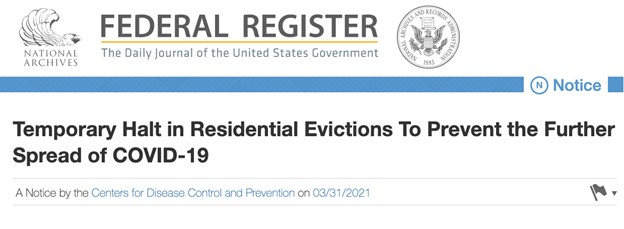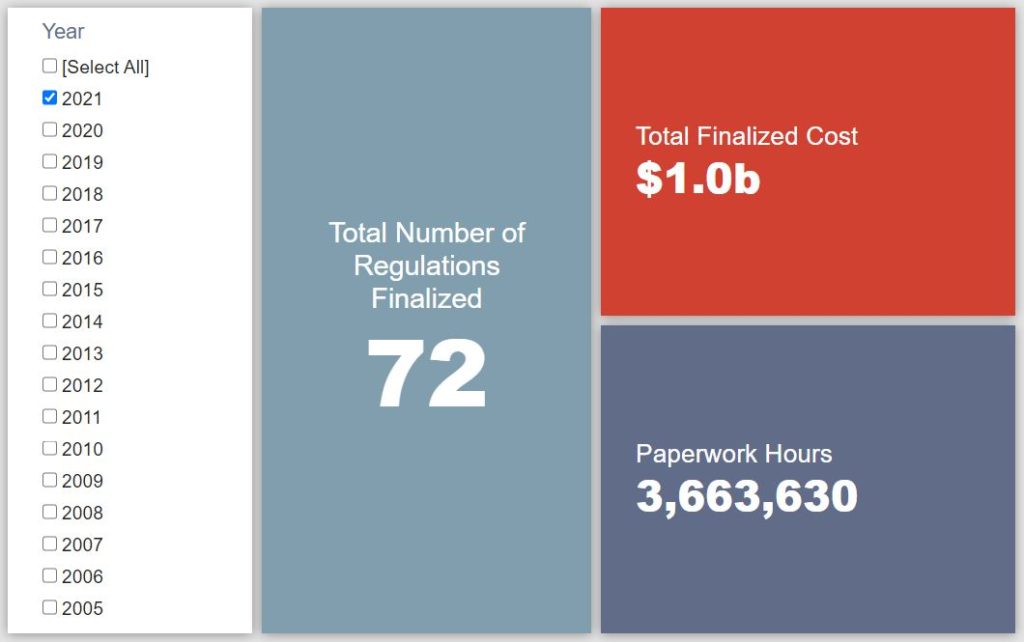Week in Regulation
April 5, 2021
An Almost-Nothing Week
Last week was an incredibly quiet one in terms of new regulatory activity. There were only three rulemakings with some quantified economic impact. All three were relatively mundane aircraft safety rules with fairly minimal costs. Across all rulemakings, agencies published $7.7 million in total net costs but made no measurable changes to the level of annual paperwork burden hours.
REGULATORY TOPLINES
- Proposed Rules: 38
- Final Rules: 60
- 2021 Total Pages: 17,462
- 2021 Final Rule Costs: $1 Billion
- 2021 Proposed Rule Costs: -$8.3 billion
NOTABLE REGULATORY ACTIONS
As mentioned above, there were no significant actions (at least in terms of measurable economic impact). The most impactful rule was an airworthiness directive with $6.8 million in costs.
CONGRESSIONAL REVIEW ACT UPDATE
On March 23, the first joint resolution of disapproval under the Congressional Review Act (CRA) of this term was introduced. CRA resolutions essentially seek to wholly rescind specific final rules within a set timeframe. The significance of these resolutions is discussed further here. In the interest of providing a public accounting of the potential economic impact of these actions should they pass, the American Action Forum (AAF) will provide a weekly update of the rules being targeted and any measurable economic effects included in their original analyses.
| Agency | Rule | House Res? | Senate Res? | Original Costs/Savings ($ Million) |
| EEOC | Update of Commission’s Conciliation Procedures | X | X | |
| EPA | Oil and Natural Gas Sector: Emission Standards for New, Reconstructed, and Modified Sources Review | X | X | -31
|
| OCC | National Banks and Federal Savings Associations as Lenders | X | X | |
| SEC | Procedural Requirements and Resubmission Thresholds Under Exchange Act Rule 14a-8 | X | X | -10.5 |
| HHS | Securing Updated and Necessary Statutory Evaluations Timely | X | 104.5 | |
| SSA | Hearings Held by Administrative Appeals Judges of the Appeals Council | X |
TRACKING THE ADMINISTRATIONS
As we have already seen from executive orders and memos, the Biden Administration will surely provide plenty of contrasts with the Trump Administration on the regulatory front. And while there is a general expectation that the new administration will seek to broadly restore Obama-esque regulatory actions, there will also be areas where it charts its own course. Since the AAF RegRodeo data extend back to 2005, it is possible to provide weekly updates on how the top-level trends of President Biden’s regulatory record track with those of his two most recent predecessors. The following table provides the cumulative totals of final rules containing some quantified economic impact from each administration through this point in their respective terms.
![]()
After multiple weeks of relative stability across all three administrations, there appears to be some significant divergence. The quiet week kept the Biden totals relatively static, but similar timeframes in the Trump and Obama terms saw swings in the billions of dollars. For the Trump Administration, the main driver was a Securities and Exchange Commission rule with $4.2 billion in costs. For the Obama Administration, its first round of updated fuel standards led the way with $1.5 billion in costs. It remains to be seen if this is truly the point in which administrations’ regulatory activity kick into high gear, but if so the Biden Administration looks to be a step behind thus far.
THIS WEEK’S REGULATORY PICTURE
By Thomas O’Rourke, Regulatory Policy Intern
This week, the Centers for Disease Control and Prevention (CDC) extends its eviction moratorium.

On March 31, the CDC published a Federal Register notice extending the moratorium on evictions for eligible tenants to June 30, 2021, citing public health concerns. Though the notice acknowledges both the decreasing transmission rates across the country and the efficacy of approved vaccines, it contends that the spread of the virus is still a major public health threat. The CDC describes eviction moratoria as a particularly “effective public health measure utilized to prevent the spread of communicable disease.”
The notice cites evidence suggesting that evictions increase the risk of transmission, pointing to data demonstrating that evicted persons tend to join crowded households unable to comply with public health recommendations. Moreover, the notice argues that increases in evictions will necessarily lead to a rising homeless population, and that “people experiencing homelessness are at high risk for COVID-19.”
The CDC maintains the same eligibility criteria detailed in the initial moratorium released in September. That is, individuals must meet five standards, including that they are unable to afford rent, have exhausted all other means of government assistance, and would likely be rendered homeless as a result of eviction. Moreover, the notice does not extend to individuals who have violated certain terms of their leases, such as “engaging in criminal activity” or “threatening the health and safety of other residents.”
The notice also sidesteps the mandates of the Administrative Procedure Act (APA). Under the APA, rulemakings have to go through a lengthy notice and comment period before coming into effect, but the CDC claims that “this Order is not a rule…but rather an emergency action.” Even if the notice does qualify as a rule, the CDC writes, “there is good cause to dispense with prior public notice and comment…considering the public health emergency.” Therefore, regardless of whether the directive is considered to be a rule under the APA, the CDC is not required to go through the traditional procedure.
TOTAL BURDENS
Since January 1, the federal government has published $7.3 billion in total net cost savings (with $1 billion in new costs from finalized rules) and 7.3 million hours of net annual paperwork burden reductions (with 3.7 million hours in increases from final rules).












